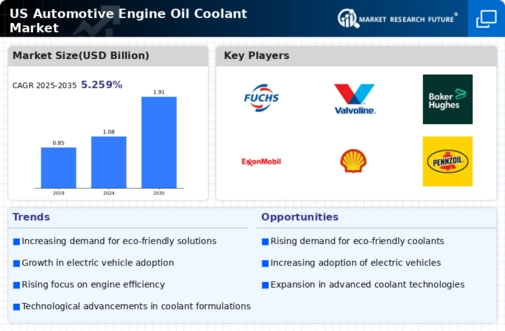The US Automotive Engine Oil Coolant Market is characterized by a dynamic competitive landscape where various companies strive to enhance their market presence through innovative products and strategic initiatives. The market is influenced by factors such as evolving consumer preferences, regulatory standards, and advancements in technology. Companies are increasingly focusing on developing high-performance engine oil coolants that offer improved protection, efficiency, and longevity, catering to both conventional and advanced engines.
The competition is not only among established players but also assesses the impact of new entrants, which brings fresh ideas and approaches to the market. Continuous research and development, coupled with strategic partnerships and collaborations, are vital for these companies as they seek to gain a competitive edge and respond to the shifts in market demands.Fuchs Lubricants holds a strong position in the US Automotive Engine Oil Coolant Market, recognized for its comprehensive range of high-quality automotive lubricants.
The company leverages its extensive experience and technical expertise to deliver products that cater to the specific needs of consumers and automotive professionals. Fuchs Lubricants focuses on innovation, consistently developing advanced formulations that enhance engine protection and performance. The company maintains a robust distribution network, ensuring accessibility and availability of its products across various regions in the US. Its strength lies in its commitment to quality and customer satisfaction, which has earned it a loyal customer base.
The brand's emphasis on sustainability and environmental responsibility also resonates well with a growing segment of eco-conscious consumers in the market.Valvoline is another significant player in the US Automotive Engine Oil Coolant Market, known for its extensive lineup of lubricants and the quality of its products. The company offers a variety of engine coolants tailored to meet the specific requirements of different vehicle types. With a historical commitment to automotive innovation, Valvoline has been at the forefront of introducing cutting-edge technology in its formulations that help improve the overall performance and longevity of engines.
The company has built a strong presence through strategic partnerships, distribution agreements, and a wide-reaching retail footprint, making its products readily available to consumers across the US. Valvoline's strengths also extend to its robust marketing strategies and brand recognition, bolstered by its proactive approach in mergers and acquisitions aimed at expanding its technological capabilities and market share within the automotive coolant sector. These initiatives reinforce Valvoline's position in the competitive landscape, catering to the diverse needs of both individual consumers and commercial automotive segments.























Leave a Comment